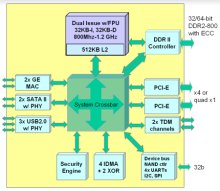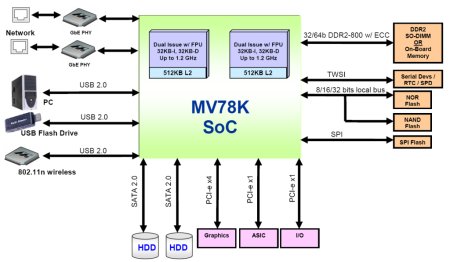Dual-core ARM SoC clocks to 1.2GHz
May 14, 2008 — by Eric Brown — from the LinuxDevices Archive — 22 views [Updated: May 15, 2008] — Marvell is sampling three low-power system-on-chips (SoCs) that clock up to 1.2GHz, and target networking applications. The dual-core MV78200 and single-core MV78100 and MV76100 are based on Marvell's ARMv5TE-compliant Feroceon core, and are available with a development board and… Linux BSPs (board support packages).
[Updated: May 15, 2008] — Marvell is sampling three low-power system-on-chips (SoCs) that clock up to 1.2GHz, and target networking applications. The dual-core MV78200 and single-core MV78100 and MV76100 are based on Marvell's ARMv5TE-compliant Feroceon core, and are available with a development board and… Linux BSPs (board support packages).
The MV7x SoCs are the first in Marvell's “Discovery Innovation Series,” not to be confused with the company's “Discovery” series of controllers. The SoCs are said to enable “green” system design for devices including routers, base stations, high-volume laser printers, storage devices, and single-board computers (SBCs).
The single-core MV78100 is pin-compatible with the dual-core MV78200 version, says the company, and the MV76100 is a stripped down, more cost-effective version of the MV78100. They offer an on-chip crossbar architecture that provides any-to-any connectivity for concurrent transactions among multiple logical units, says Marvell. Initially supporting system clocks between 800MHz and 1.2GHz, the SoCs are ultimately expected to clock to 2GHz or beyond, according to Marvell's director of marketing, Viren Shah.


Dual-core MV78200 (left) and single-core MV78100 (right)
(Click either to enlarge)
The MV78200 offers the following specifications, says Marvell:
- 2 x dual-issue Feroceon-based cores with Vector Floating Point (VFP) support
- 800MHz, 1GHz and 1.2GHz clock speeds
- 32KB instruction and data L1 caches per core
- 512KB unified L2 cache per core
- High-bandwidth DDR2 memory interface (up to 800MHz data rate)
- Up to 4 x gigabit Ethernet ports
- 2 x PCI Express ports (x4 or Quad x1)
- 3 x USB 2.0 ports with PHYs
- 2 x SATA 2.0 ports with PHYs
- Security engine

MV78200 in typical implementation
(Click to enlarge)
The MV7x SoCs are supported by a reference design development platform, including software drivers, toolchain, and BSPs for Linux, VxWorks, and BSD.
The Feroceon micro-architecture that drives the core of the new MV7x SoCs is also used in the company's Orion processor, which is commonly found in network-attached storage (NAS) devices. The Orion architecture was supported in the most recent 2.6.25 Linux kernel release. Other SoC (system-on-chip) vendors that have licensed the ARM instruction set architecture and implemented their own micro-architectures include Intel, with the XScale and XScale v3 micro-architectures, and Freescale, with i.MX.
Marvell has long been known for its NIC chips, including wireless chipsets, and for other embedded, network infrastructure, and storage processors. But then in 2006, it expanded its horizons by acquiring Intel's mobile XScale/Bulverde chip family, after which it quickly ramped up production. Marvell's XScale-based PXA series are a mainstay in Linux-based embedded devices.
Stated Dr. Simon Milner, VP/GM at Marvell, “With the launch of these enterprise-focused SoCs, Marvell sets new standards for system performance and integration with very low power consumption for a gigahertz class processor core.”
Availability
Marvell is currently sampling the new MV7x Discovery Innovation Series SoCs, and development boards are available now, says the company. Production is expected in the third quarter.
This article was originally published on LinuxDevices.com and has been donated to the open source community by QuinStreet Inc. Please visit LinuxToday.com for up-to-date news and articles about Linux and open source.